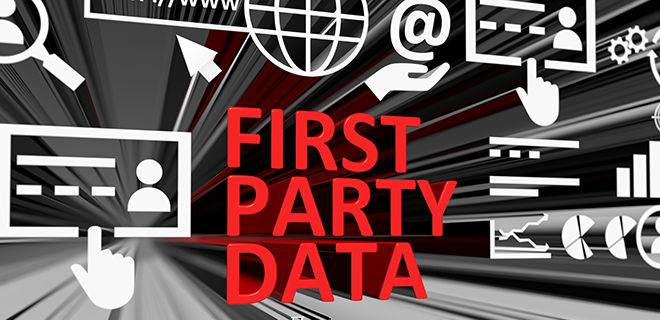
We’ve written a lot about the power of first-party data strategies and their ability to balance the scale back toward publishers. Often, though, publishers don’t even know what they have, how to define it, or how to even acquire or activate it.
That’s why I was excited when I scrolled through this Twitter thread by Ben Guez, Enterprise Sales, Americas, Kevel, about 6 First-party Data Strategies That Publishers Should Consider Adopting in 2023.
I reached out to him and ask him if he could dig deeper into the strategies he outlined in his thread, including user registration, expanded interest level registrations, SSO (Single Sign On), event-based tracking and analytics, and surveys and polls.
5 First-party Data Strategies For Publishers in 2023
1. User Registrations
Lynne d Johnson: I think a lot of pubs are still taking it slow when it comes to preparing for a life post-cookie. But there are some simple things they should be doing right now in terms of first-party data collection, whether the third-party cookie goes away or not. I saw in your Twitter thread that you talked about user registrations as one of the first things pubs should be thinking about. And what are the challenges that some publishers might face when they take this road?
Ben Guez: User registrations can seem simple at first glance, but I believe they show how publishers are thinking about their product in terms of the cookie landscape — gathering first-party data, event tracking, and other related issues. Better expressions of these product strategies will ultimately help publishers to shield themselves from future privacy challenges, legislation, and shifts that they can’t control while also creating more value for their users.
The post-cookie era will come and publishers need to take steps to build and nurture audiences from their own position in the world the first step in doing that is to take inventory of their touchpoints with users. User registrations are usually one of the first touchpoints that publishers have.
Different categories of publishers will need to have different approaches — but registrations allow you to take more steps together with users. It yields more opportunities to gather first-party data, build better audience cohorts, and then create better publishing products through personalization.
But of course, there are challenges to executing. For one, it’s not always easy to prompt users to sign up – especially if you’re a publisher whose revenue model depends mostly on aggregating traffic, impressions, and ad revenue.
We all know what it’s like to sift through news aggregation sites, social media platforms, and newsletters to find topics of interest where links take us to sites we may have never visited before — and may not ever visit again. This type of rented traffic can make it difficult to retain users or incentivize repeat traffic or user registrations.
This is where some thought needs to be applied to the type of publisher you are, the types of users you have, and why users spend their time with you.
Once publishers determine their value propositions to certain cohorts, they can begin to create even more value; and then try and strategize a way to acquire more registrations.
2. Expanded Interest Level Registrations
LdJ: As an extension of logins, I saw you posted about expanded interest-level registrations. Can you talk a little more about what this is?
1B/ Expanded Interest Level Registrations
Not all publishers can execute this strategy, but with some creativity, even companies that don’t have a social feed can provide some type of progressive user-generated profiling so you can tailor user experiences. pic.twitter.com/rrwBYUwWb4
— Ben Guez (@the_ad_dude) January 9, 2023
BG: I love the idea of expanded interest level fields within the registration of a platform or site because it immediately and inherently builds better audiences for the publisher while also giving them the opportunity to deliver increased value for users.
The caveat is, you must be able to actually deliver the interest topics to users in the first place – but if you can – segmenting particular value segments for users can be instrumental in knowing how your total audience is broken down by particular interests.
User registrations are usually only a few steps, i.e. name > email address > activate email address; but by adding extra steps that point to the future value you will deliver, users will oftentimes feel empowered to offer up more personal data.
A counterpoint is you can definitely go too far with your registration process. If you ask too many questions or get too personal for your category, you risk users deciding the juice isn’t worth the squeeze. So stay laser-focused on your audience, keep looking at your platform from their point of view, and you’ll be in a much better position to succeed.
3. Single Sign On
LdJ: Consent fatigue and password fatigue are real problems when it comes to acquiring consumers’ first-party data. You talk about publishers adopting Single Sign On (SSO) as a solution for those challenges. But SSO also has many other benefits for pubs. What are some of those benefits?
with your own username & password, but your accompanying data eg {first name} {last name} {email}, etc was shared with them via SSO. pic.twitter.com/T2Vbi1h8mn
— Ben Guez (@the_ad_dude) January 9, 2023
BG: SSO does a lot of things for publishers while simultaneously creating a simpler user experience for customers.
From a user experience perspective, SSO enables customers to login into your platform once for frictionless access to everything you offer. They don’t have to remember 101 passwords, and that’s especially important today with more apps available than ever and with remote workers constantly using multiple technologies for business and personal use.
But the benefits don’t stop there. On the publisher’s side, SSO yields better security almost for the same reasons why it’s a better user experience.
When users are constantly prompted to change passwords and fatigue sets in, it has a chain reaction. Passwords get simpler, which makes their logins less secure, and now you have a growing chance for a security breach.
Taking this one step further, if SSO reduces the number of password resets on the user side, that means it also reduces the amount of time your IT team has to spend managing user resets internally. So it can also provide big time savings for teams which means they can focus on different IT issues altogether.
4. Event-based Tracking
LdJ: You also mentioned event-based tracking as another way that pubs should be thinking about their first-party data. Do you see this becoming more of a trend?
BG: Definitely, and especially alongside more progressive profiling-type initiatives that we’ve already discussed — Expanded Interest Level Registrations. Event-based tracking gives more behavioral insights into how users are interacting with your digital properties.
For instance, it’s one thing if a user says he or she is interested in Sports and Technology in their registration, but event-based tracking allows you to debunk that if they spend all of their time in, say, Arts & Leisure categories.
What’s happening more and more in event tracking is the creation of ML and AI-based historical event models based on user behaviors and then predicting what future users with similar behaviors will do.
A more complex use of event-based tracking can be even more powerful for certain types of publishers, too. What’s happening more and more in event tracking is the creation of ML and AI-based historical event models based on user behaviors and then predicting what future users with similar behaviors will do.
This can allow publishers to create first-party cookies and then invest in valuable segments by serving more tailored content to them in other parts of their product like different pages, email newsletters, an app, and more.
Further, event-based tracking just gives publishers and digital owners more control over their user experience and the data that they can collect from it. This enables them to make better insights into how their products affect user behavior and then make holistic improvements in their product or audience-building activities.
5. Surveys & Polls
LdJ: For the past year or so, I’ve been talking about surveys and polls as a means of acquiring zero-party data — a term that everyone in the industry hates me using. But seriously, surveys and polls are an important part of first-party data aggregation. What’s your thinking on this?
BG: In general, and assuming you’ve cultivated your audience and have a product that users love, surveys and polls can be extremely valuable.
In a recent article How to Come First in First-Party Data, Erin Hennessy, Executive Director of Product Marketing & Insights at The New York Times discusses their ‘back to the basics strategy of using surveys to acquire first-party data even though they have a lot of proprietary and sophisticated audience data as well.
In my opinion, the real key to acquiring meaningful data from users is to build products that people have an interest in and a passion for.
One of my favorite quotes from her is, “…building trust and engagement with those audiences is part of it and then figuring out how to operationalize it…[this] highlights our ability to meet an audience’s interests and passions while also giving us a lot of new signals.”
In my opinion, the real key to acquiring meaningful data from users is to build products that people have an interest in and a passion for.
In other words, both hands wash each other in the zero- or first-party data strategy. If you don’t build a great product, you won’t have the opportunity to ask for meaningful feedback.
There’s no shortcut to building something that lasts. It takes time, effort, and trust to transition from just acquiring data from users to building a relationship with them. Once you cross that chasm you’ve started to take more control over your destiny in the cookieless world. But be careful, with great power comes great responsibility.
